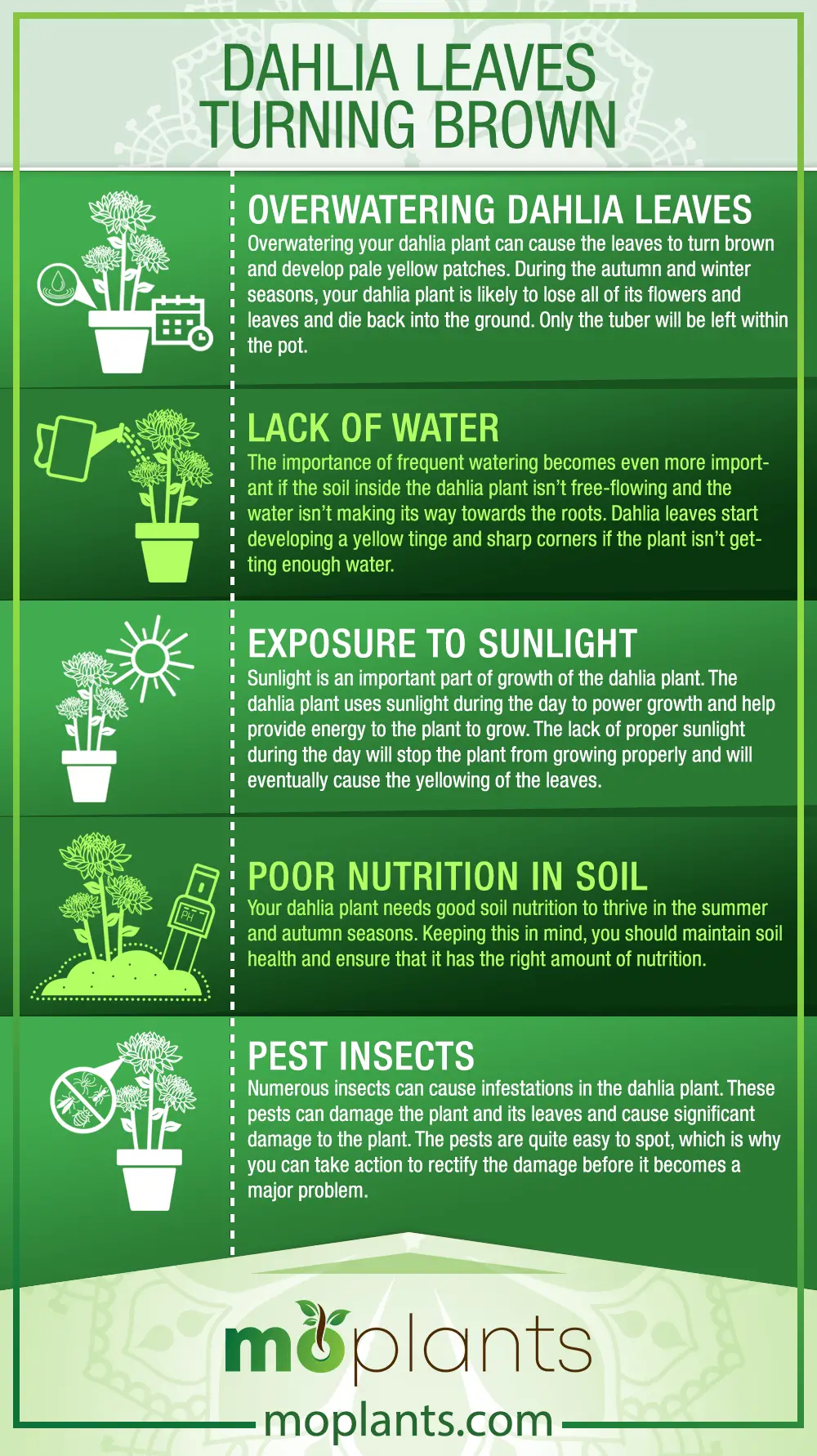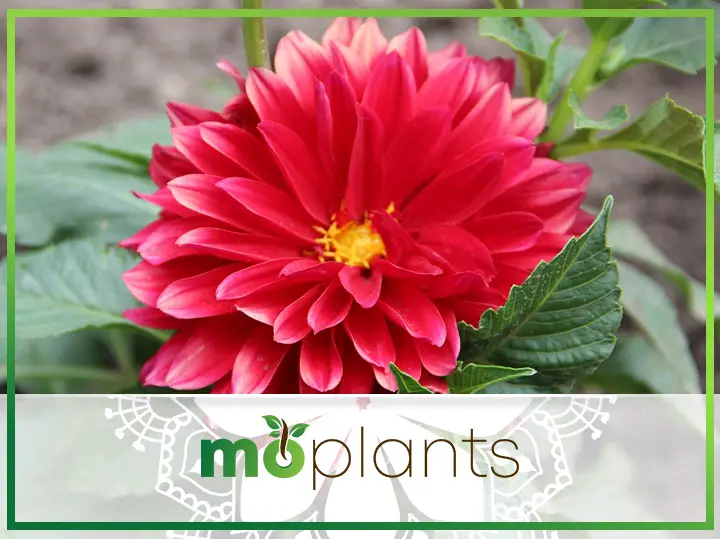Dahlia plants are common in the spring season and can sprout back up again after dying in the winters. Once they grow in the spring season, they can face certain issues that impact the overall health and wellness of the plant.
One of the common problems facing dahlia plants is the leaves turning pale brown in texture and color. Lack of water and moisture, pest diseases, insects, improper soil quality, and too much water are just some of the factors that can cause dahlia plants to turn brown in color and drop their original texture.
A quick remedy for brown dahlia leaves should ensure that the pH level of the soil is no more than 6.3 and less than 5.7. Additionally, the soil should be kept damp and the plants should receive at least 6 hours of sunlight on a regular basis.
Dahlia leaves that have already turned brown will most likely die, but the correct fixes will ensure that the growth is speedy and the new leaves don’t have brown spots on them.
There are certain symptoms to identify what is going wrong with your dahlia plant. In this article, we take a look at what can be done to make sure that dahlia leaves return back to their perfect health. Stay with us to find more.
Overwatering Dahlia Leaves
Overwatering your dahlia plant can cause the leaves to turn brown and develop pale yellow patches. During the autumn and winter seasons, your dahlia plant is likely to lose all of its flowers and leaves and die back into the ground. Only the tuber will be left within the pot.
When the plant is dying and has become dormant in nature, you shouldn’t over-water it. Over-watering the plant will mean that the roots become soggy and won’t be able to attract nutrients and water in the manner required by the plant. Over-watering can cause the roots to lose their ability to take up nutrients from the soil and the water.
The same process can also take place during spring. When spring arrives, the dahlia plant will start growing new shoots and pick up growth patterns. If the plant is overwatered during the spring season, the new leaves that come out of the shoot will be yellow in color and have brown patches on them. The leaves will have crispy edges and have yellowish texture on them. The rapidly increasing development of brown color on the leaves will signal the death of the specific leaves and eventually the plant.
Solution:
You can find a solution to this problem by practicing the following tips:
- Make sure you only water your dahlias once a week during the spring season.
- As the hotter months of summer settle in, you should remember to water the plant twice a week. Do not water the plant every day.
- Do not water your dahlia plant if the pot or bed is outdoors. The rainwater would have already provided sufficient water to the plant.
- The soil should be damp but not completely soaked in water
Lack of Water
The second problem causing brown leaves in dahlia plants is the complete opposite of what we discussed above. Dahlia’s may not need a lot of water, but in comparison to some other self-sufficient plants, they require external sources of water twice a week.
The importance of frequent watering becomes even more important if the soil inside the dahlia plant isn’t free-flowing and the water isn’t making its way towards the roots. Dahlia leaves start developing a yellow tinge and sharp corners if the plant isn’t getting enough water. The edges specifically turn brown over time and crumbly/dry in nature. The entire leaf eventually turns brown if the lack of proper watering persists.
Solution to Lack of Watering:
You can find a solution to this problem by practicing the following tips:
- If the area you live in has low rainfall around the year, you can create a depression of soil around the region of the dahlia to trap excess water.
- If the area you live in has a high amount of rainfall, you can create a mound to establish a water runoff.
- You should water the plant once every 2 to 3 days during extremely hot summer days. Creating a watering schedule twice or thrice a week will help establish a good routine during hot summers.
- Once the temperature has cooled down during the spring season, you can water once a week to avoid over-watering.
Exposure to Sunlight
Sunlight is an important part of growth of the dahlia plant. The dahlia plant uses sunlight during the day to power growth and help provide energy to the plant to grow. The lack of proper sunlight during the day will stop the plant from growing properly and will eventually cause the yellowing of the leaves. An improper supply of sunlight will eventually mean that the leaves turn yellow, develop a brown color and start falling off. Planting the dahlia plant in direct shade without exposure to sunlight will cause the plant to wither over time and die. Brown leaves will just be the start of the process.
If you have your dahlia plants indoors, they will get some sunlight, but it won’t be enough to give them the energy they require. Even if your dahlia plant is getting some reflected light, it will not be enough for them to grow.
Too much sunlight can also be an issue with your dahlia plant if you are living in a typically hot region with direct exposure to the hot sun. The hotness of the sun may cause the plants to turn brown around the edges after being scorched.
Solution:
You can find a solution to this problem by practicing the following tips:
- You can replant your dahlia plant in an area that gets 6 hours of direct sunlight during the day. This is the bare minimum and should be guaranteed.
- If you live in a particularly dry or hot area, then it will serve you best to place the plant in a partially shaded area. Under a shed will work fine now. Direct sunlight in hot areas can cause the plant to grow dry with time.
Poor Nutrition in Soil
Your dahlia plant needs good soil nutrition to thrive in the summer and autumn seasons. Keeping this in mind, you should maintain soil health and ensure that it has the right amount of nutrition.
There are 17 important ingredients that are considered essential for the growth of plants. These ingredients include many nutrients, but phosphorous, potassium, and nitrogen happen to be the most important of the lot. These nutrients are called macronutrients because plants digest them in the largest amounts from the soil that is present.
The importance of these three nutrients can be gauged by the fact that fertilizers happen to have all three of them stored within them. Fertilizers with these three nutrients are called ‘complete nutrients,’ but they aren’t complete at all. Sulfur, calcium, and magnesium happen to be the secondary nutrients and are also important for plants. Other micronutrients or nutrients with lesser efficiency, including copper, iron manganese, boron, and zinc, are also relatively important for plant health.
The quality of all soil is found by taking these nutrients into perspective and seeing how much of each a given soil actually possesses. Besides the measure of nutrients, plant health can also be gauged by the acid-alkaline ratio or the pH reading it shows.
Testing
The most common method for identifying the health of your soil is testing. This method involves taking a sample of your soil and sending it to a component resource to generate a report of the results. These results measure the pH rate and the presence of calcium, potassium, phosphorous, and magnesium in the soil.
The perfect pH for plants lies between 6.5 and 6.8, as plants within this range absorb the most nutrients. If the pH scale is disturbed, the number of nutrients in the soil won’t matter as your plant will not be able to digest the relative nutrients.
The best time to get your soil tested is during the mid of spring or the mid of fall. This is when the soil happens to be stable in condition.
Ways to Improve Garden Soil
If the tests find out that your soil is lacking in one way or the other, then you need to shift your attention towards improving it. Some of the tips and methods you can follow for improving soil quality include:
Keep the Diet Organic
Spring usually brings with it an increase in underground activity. New organisms stretch and yawn while forming for the first time. The presence of living soil and nutrients below the soil actually helps in the emergence of the plants above the soil.
Adding organic material to your soil can help improve the nutrients present inside. Autumn is the best season to start this process, as this is when the cycle begins. You can add garden debris, kitchen scraps, fallen leaves, and even apples taken from fruit trees to your soil. This will give something organic for your soil to ingest and improve the quality of plants on top of the soil.
Supply What Is Missing
Once you perform tests on the soil, you will be able to find out exactly what is missing from your soil. These soil tests do a good job of pointing out the fertilizer needs of your soil. Once you know just what is missing, you can add the relevant fertilizer to get the best results.
You can head to the nearest garden center and can get an entire mix of fertilizers for your soil. All you need to do know is scratch fertilizers within the first 2 inches of your vegetable gardens. Another way to do this is through the use of chickens. You can dump all organic materials in a specific patch and can keep your chickens there. The chickens will then do what they are good at doing, i.e., shredding the organic material and burying it within the top layer. Additionally, the chickens will drop their droppings as well, which can significantly boost soil production.
Cut the Weeds
Your garden usually wakes up from a deep slumber in spring, which is when you should manage the weeds as well. Before you begin planting in your garden, you should get rid of the weeds, as they take away all of the organic food from your living soil without adding any value as such to your property.
Fall mulching is the best way to get rid of weeds. You can easily get rid of the weed in the manner you deem ideal. You can pull weeds from their root and take them out before they create a problem during the spring season. Follow these steps by covering the garden bed from the start of spring.
Keeping up with soil maintenance is perhaps the most important part of creating a landscape. Plantation will only be successful if the soil is well-looked after and has no issues with the macronutrients required for growth.
Pest Insects
Numerous insects can cause infestations in the dahlia plant. These pests can damage the plant and its leaves and cause significant damage to the plant. The pests are quite easy to spot, which is why you can take action to rectify the damage before it becomes a major problem.
Solution:
You can find a solution to this problem by practicing the following tips:
- Spray pesticide on all new growth to limit pests
- Spray pesticide when the sun is down to kill pests and avoid brown leaves
Dahlia plants don’t require a lot of care but can develop brown leaves if neglected. You can follow the tips in this article to avoid brown leaves and take care of your dahlia plant.
Infographic



